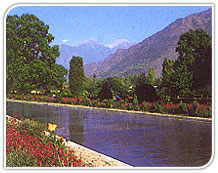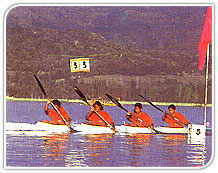Srinagar
City Guide
 Srinagar,
the state capital, is situated at an altitude of 1,730 meters above sea
level. It is connected by Indian Airlines and Jet Airways flights
directly to Jammu and New Delhi, and hence to every part of the national
network. An all-weather road to Jammu, which in turn is connected, too
many parts of North India connects Srinagar. Srinagar's nearest railhead
is Jammu, which in turn connects all parts of the country, including
Delhi, Kolkata, Pune, Murnbai and Kanyakumari, Kashmir receives most of
its rainfall in spring. If you've longed for the delights of a houseboat
holiday, now is the time to try one out Srinagar is a unique city
because of its lakes - the Dal, Nagin and Anchor. The River Jhelum also
flows through a part of the city.
Srinagar,
the state capital, is situated at an altitude of 1,730 meters above sea
level. It is connected by Indian Airlines and Jet Airways flights
directly to Jammu and New Delhi, and hence to every part of the national
network. An all-weather road to Jammu, which in turn is connected, too
many parts of North India connects Srinagar. Srinagar's nearest railhead
is Jammu, which in turn connects all parts of the country, including
Delhi, Kolkata, Pune, Murnbai and Kanyakumari, Kashmir receives most of
its rainfall in spring. If you've longed for the delights of a houseboat
holiday, now is the time to try one out Srinagar is a unique city
because of its lakes - the Dal, Nagin and Anchor. The River Jhelum also
flows through a part of the city.
Most houseboats on the Nagin and the Jhelum are situated on the banks of
the lake, and can be accessed directly from land without the help of a
shikara, while all those on the Dal require a shikara to get to and from
them. Most houseboats on the Dal are situated in long straggling rows;
some face
the Boulevard, Srinagar's most exciting address, while others are
situated singly or in groups of two and three.
The location of
a houseboat tells us nothing about its class, but before checking into
one, there are a few factors, which you may like to consider. A
honeymoon couple may want to be away from it all, and may choose a
houseboat with few, if any, close neighbors. To them, it will be an
advantage to stay in the interior of the lake, accessible by a half-hour
long shikara ride. A family with young children on the other hand may
find themselves better served in an area, which overlooks the Boulevard
where a crossing takes just five minutes. When your houseboat is in a
busy area of the Dal, it is enjoyable just to sit on the balcony and
watch the world row by.
Each houseboat has anything between
two and four bedrooms in it with attached bathrooms and a common sitting
and dining room. The charges of a houseboat always include all meals and
a certain number of crossings by shikara to and from the houseboat.
Houseboats offer far more personalized service than hotels because of
the far higher host guest ratio. On the other hand, fellow guests at the
same houseboat tend to interact much more than if they were staying at
the same hotel. Which is why houseboats are ideal for a large group of
eight or more adults.
The Dal is famous not only for its
beauty, but for its vibrance, because it
sustains
within its periphery, a life that is unique anywhere in the world. The
houseboat and shikara communities have lived for centuries on the Dal,
and so complete is their infrastructure on the lake, that they never
have to step on land! Doctors, tailors, and bakers - you'll see them all
in tiny wooden shops on the lake, near picturesque vegetable gardens and
acres of lotus gardens. A shikara ride is one of the most soothing,
relaxing aspects of a holiday in Kashmir. It can be an hour-long ride to
see the sights of the Dal, a shopping- by-shikara expedition to visit
handicraft shops within the periphery of the lake; or a whole day trip
to visit important city landmarks. Because the Dal is so central to the
landscape of Srinagar, many places of tourist interest have, over the
ages, been built in its vicinity.
Nishat and Shalimar gardens
as well as Hazratbal mosque are directly accessible by shikara.
Mughal
Gardens:
Kashmir was a favourite of the Mughal emperors who
visited it as often as they could. Cool and refreshing after the plains
of North India where the business of governance kept them, they planted
gardens with stepped terraces and flowing watercourses. When they rested
in their gardens, they dreamt they were in paradise. Cheshmashahi is the
first Mughal garden you will pass after Nehru Park. Built at a height
above the city, its views are as stupendous as its layout. The smallest
of Srinagar's Mughal gardens, Cheshmashahi has only three terraces in
addition to a natural spring of water enclosed in a stone pavilion.
The next garden along the road that encircles the Dal is the
Nishat,  built
by Empress Nur Jahan's brother Asaf Khan. The largest of the gardens,
Nishat has several terraces, a central watercourse and a majestic site
between the Dal and the Zabarwan hills. Jehangir, the Mughal emperor,
whose love for Kashmir was legendary, planted the third Mughal garden -the
Shalimar -. Shaded by magnificent chinar trees, the Shalimar is a
series of stone pavilions and flowing water with paint-box bright
flowerbeds.
built
by Empress Nur Jahan's brother Asaf Khan. The largest of the gardens,
Nishat has several terraces, a central watercourse and a majestic site
between the Dal and the Zabarwan hills. Jehangir, the Mughal emperor,
whose love for Kashmir was legendary, planted the third Mughal garden -the
Shalimar -. Shaded by magnificent chinar trees, the Shalimar is a
series of stone pavilions and flowing water with paint-box bright
flowerbeds.
Across the Dal from Shalimar is the mosque of Hazratbal,
the only one of its kind architecturally in Kashmir. Made of white
marble with a dome and a mina- ret, Hazratbal is the repository of a
single hair of the Prophet Mohammed, exhibited to the public on certain
days of the year.
Srinagar, the state capital, is situated at an altitude of 1,730 meters above sea level. It is connected by Indian Airlines and Jet Airways flights directly to Jammu and New Delhi, and hence to every part of the national network. An all-weather road to Jammu, which in turn is connected, too many parts of North India connects Srinagar. Srinagar's nearest railhead is Jammu, which in turn connects all parts of the country, including Delhi, Kolkata, Pune, Murnbai and Kanyakumari, Kashmir receives most of its rainfall in spring. If you've longed for the delights of a houseboat holiday, now is the time to try one out Srinagar is a unique city because of its lakes - the Dal, Nagin and Anchor. The River Jhelum also flows through a part of the city.
built by Empress Nur Jahan's brother Asaf Khan. The largest of the gardens, Nishat has several terraces, a central watercourse and a majestic site between the Dal and the Zabarwan hills. Jehangir, the Mughal emperor, whose love for Kashmir was legendary, planted the third Mughal garden -the Shalimar -. Shaded by magnificent chinar trees, the Shalimar is a series of stone pavilions and flowing water with paint-box bright flowerbeds.